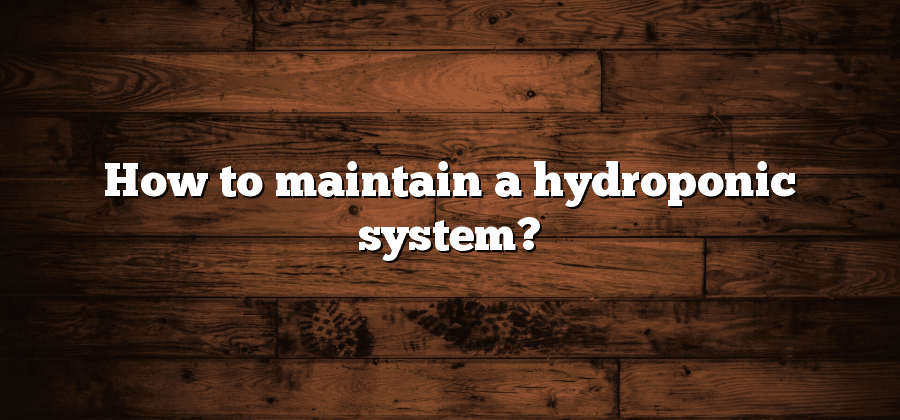Understanding the Basics of Hydroponics
Hydroponics is a modern method of cultivation that is gaining popularity among gardening enthusiasts. Unlike traditional soil-based gardening, hydroponics involves growing plants in nutrient-rich water, without the use of soil. This innovative technique utilizes a variety of systems such as nutrient film technique (NFT), deep water culture (DWC), and aeroponics to provide optimal growing conditions for plants.
One of the key advantages of hydroponics is its ability to produce higher yields in a shorter time frame compared to traditional gardening methods. This is because hydroponic systems deliver water and nutrients directly to the plant’s roots, allowing them to uptake the necessary elements more efficiently. In addition, hydroponics eliminates the risk of soil-borne diseases and pests, creating a cleaner and healthier growing environment. Whether you are a beginner or an experienced gardener, understanding the basics of hydroponics is essential to successfully embark on this exciting and rewarding gardening journey.
Selecting the Right Hydroponic System for Your Needs
When it comes to selecting the right hydroponic system for your needs, there are a few key factors to consider. First and foremost, think about the space you have available. Hydroponic systems can range in size from small-scale setups suitable for a single plant, to larger systems designed to accommodate multiple plants. Assess the size of your available space and determine how many plants you want to grow. This will help you choose a hydroponic system that is both practical and efficient for your specific needs.
Next, consider the type of plants you plan to grow. Different plants have different requirements, and some hydroponic systems may be better suited for certain types of plants. For example, if you want to grow vine crops like tomatoes or cucumbers, a system that includes trellises or support structures would be beneficial. On the other hand, if you plan to grow leafy greens or herbs, a system that focuses on nutrient film technique (NFT) or deep water culture (DWC) may be more suitable. Take the time to research the specific needs of the plants you want to grow, and choose a hydroponic system that is compatible with those requirements.
Choosing the Ideal Location for Your Hydroponic System
Choosing the ideal location for your hydroponic system is crucial to its success. There are several factors to consider when determining the best place to set up your system. Firstly, it is important to find a location that receives ample natural light. Since plants grown in hydroponics rely solely on artificial light sources, positioning your system in an area with access to sunlight can help supplement and enhance their growth. Additionally, ensure that the chosen location is well-ventilated to prevent a buildup of humidity, which can lead to mold or fungal growth. Finally, consider the proximity of the system to a water source. It is important to have easy access to water for regular maintenance and nutrient replenishment. By carefully selecting the location for your hydroponic system, you can ensure optimal growing conditions and maximize your chances of a successful harvest.
Once you have identified a suitable location for your hydroponic system, it is essential to prepare the space properly. Cleanliness is vital, as any contaminants or pathogens present can negatively impact plant health and growth. Start by thoroughly cleaning the area and removing any dust, dirt, or debris. Additionally, sanitize and sterilize all equipment and materials that will come into contact with your plants, such as pots, trays, and tools. This step is crucial in preventing the spread of pests and diseases. Lastly, consider the space requirements of your chosen hydroponic system. Ensure that there is enough room for the system to grow and expand as needed. Adequate space will allow your plants to thrive and flourish without constraints, ultimately leading to greater yields.
Monitoring and Adjusting pH Levels in Your Hydroponic System
To ensure the success of your hydroponic system, it is crucial to monitor and adjust the pH levels regularly. pH refers to the acidity or alkalinity of the nutrient solution in your system. This factor plays a significant role in the absorption of nutrients by the plants, as different pH levels can affect their availability.
Proper pH levels in hydroponics typically range between 5.5 and 6.5, with variations depending on the specific plant’s requirements. Monitoring pH can be done using a pH meter or pH test kit, both readily available in hydroponic stores or online. It is essential to check the pH levels at least once a day, ideally at the same time to maintain consistency. Any drastic changes should be addressed immediately by adjusting the pH of your nutrient solution. By regularly monitoring and adjusting pH levels, you can ensure that your plants have optimal conditions for nutrient uptake, leading to healthier and more vigorous growth.
Maintaining Proper Nutrient Levels in Your Hydroponic System
To ensure optimal plant growth and health in your hydroponic system, maintaining proper nutrient levels is crucial. Nutrients are essential elements that are necessary for plants to grow and thrive. In a hydroponic system, these nutrients are provided directly to the plants through the nutrient solution. A well-balanced nutrient solution is essential to provide plants with the necessary elements for their growth and development.
Monitoring and adjusting nutrient levels in your hydroponic system is an ongoing task that requires attention to detail. Regularly testing the nutrient solution for pH levels and nutrient concentration is necessary to ensure that plants are receiving the correct balance of essential elements. pH levels should typically be maintained between 5.5 and 6.5 for most plants to facilitate nutrient absorption. Additionally, it is important to regularly check and adjust the nutrient concentrations in the solution to avoid deficiencies or toxicities. By carefully monitoring and adjusting nutrient levels, you can ensure that your plants are receiving the optimal nutrition they need to thrive in your hydroponic system.






